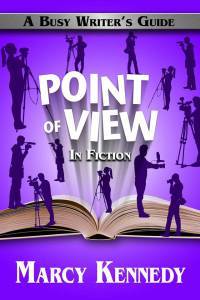How to Decide How Many POV Characters Our Book Needs
Becca and I see certain questions pop up in our email boxes over and over, and one that always comes up during NaNoWriMo season is the question of how many POVs a novel should have.
 Like so many questions, this isn’t a cut-and-dry answer; so much depends on the type of story being told, what the author needs to achieve through multiple POVs, and to a lesser degree, the experience of the writer themselves. So I’m happy author Marcy Kennedy is here with some excellent metrics to consider when planning a novel and choosing how many POV characters to include.
Like so many questions, this isn’t a cut-and-dry answer; so much depends on the type of story being told, what the author needs to achieve through multiple POVs, and to a lesser degree, the experience of the writer themselves. So I’m happy author Marcy Kennedy is here with some excellent metrics to consider when planning a novel and choosing how many POV characters to include.
 One of the most common challenges for us as writers is deciding how many point-of-view characters we should use, and yet a lot of the advice we hear can be too generic. Use the right number for your genre. Don’t use more than three.
One of the most common challenges for us as writers is deciding how many point-of-view characters we should use, and yet a lot of the advice we hear can be too generic. Use the right number for your genre. Don’t use more than three.
While those tips are good general advice, they’re often not specific enough to actually answer our question. Our story might seem to need more than the standard advice would recommend. Or there might not even be a “standard” for our genre. How do we decide how many point-of-view characters to include?
One technique we can use for figuring out what’s best for our individual story is to write down all the potential point-of-view characters we might want to use, and then ask ourselves the following questions.
Who is the protagonist?
Our protagonist is the person whose goal drives the story. Most of the time, we need our protagonist to also be a point-of-view character (and to receive the majority of our scenes). Identify them first, and then you don’t have to consider them in the rest of the questions.
Would it improve the story to include scenes from the antagonist’s viewpoint?
In some stories, we don’t want to delve into the mind of our antagonist, either because the antagonist is an especially twisted villain or because revealing the identity or plans of the antagonist would ruin the tension. In other stories, knowing the antagonist and his or her plans increases the tension as readers worry about whether our heroes will spot the trap in time.
What’s the scope of our story?
An epic fantasy spanning five planets where the fate of the galaxy is at stake might require more point-of-view characters than the coming-of-age story of a young woman in feudal Japan. Generally speaking, the smaller the scope, the fewer point-of-view characters we need. The larger the scope, the more we can reasonably use, but that doesn’t mean we must or should—which is where the other questions come in.
Does every potential point-of-view character influence the plot in a significant way?
This is a good question for checking that each potential point-of-view character is essential. If a character could be cut without having to change the plot in any significant way, or if another character could easily step in and take their place, they probably aren’t a good choice for a point-of-view character because they’re expendable.
Does including this point-of-view character’s perspective enhance the theme?
Theme is always a tricky area for writers. We don’t want readers to feel like we’re beating them over the head with our message. Theme should develop through our main character’s growth arc and the challenging decisions they face, but another way to enhance our theme is to have characters approach it from varying angles and to take different sides on the issue. Those other characters don’t necessarily need to be point-of-view characters, though. So what we want to look at is whether we need to be inside a character to truly understand their opinion and stance on the issue.
Say we’re writing a mystery and we have a detective and her partner. The detective is our protagonist. She’s the one driving our story. So do we also need scenes from the viewpoint of her partner? Maybe, maybe not.
If he’s only there to be her sounding board, then we probably never need to go into his head. But, instead, if they’re investigating a crime involving a local church and her partner is a devout Christian, then his perspective on the events and on the people involved would add new layers we couldn’t develop if all we had was the viewpoint of our atheist detective.
Which characters play a key role at the climax of the novel?
Our whole story builds up to the climax or the “final battle” where our characters fight the antagonist. The characters who are instrumental during this climax are the ones who are most important in the story. These are also good characters to consider for roles as point-of-view characters. If a character isn’t involved in the climax of the story, that’s a clue they might not be important enough to be a point-of-view character.
How many scenes might I give this character in their point of view?
If we’re only considering giving them one or two scenes, it usually means we want to make this person a point-of-view character to shoehorn in information or to show a part of the story that doesn’t need to be shown. Those aren’t good reasons to make someone a point-of-view character.
Each point-of-view character we include needs to have goals, motivations, and stakes within the story and to give a valuable, necessary perspective on the situation.
 POINT OF VIEW IN FICTION:
POINT OF VIEW IN FICTION:Point of view is the foundation upon which all other elements of the writing craft stand—or fall.
It’s the opinions and judgments that color everything the reader believes about the world and the story. It’s the voice of the character that becomes as familiar to the reader as their own. It’s what makes the story real, believable, and honest.
Yet, despite its importance, point-of-view errors are the most common problem for fiction writers.
In Point of View in Fiction: A Busy Writer’s Guide, you’ll learn
the strengths and weaknesses of the four different points of view you can choose for your story (first person, second person, limited third person, and omniscient),
how to select the right point of view for your story,
how to maintain a consistent point of view throughout your story,
practical techniques for identifying and fixing head-hopping and other point-of-view errors,
the criteria to consider when choosing the viewpoint character for each individual scene or chapter,
and much more!
Amazon | iTunes | Barnes & Noble | Kobo
Marcy Kennedy is the author of the bestselling Busy Writer’s Guides series, which focuses on giving authors deep teaching while still respecting their time. You can find her blogging about writing and about the place where real life meets science fiction, fantasy, and myth on her website.
Have a POV question for Marcy? This is an excellent opportunity to pick her brain on all things Point-of-view!
The post How to Decide How Many POV Characters Our Book Needs appeared first on WRITERS HELPING WRITERS™.
Writers Helping Writers
- Angela Ackerman's profile
- 1014 followers



